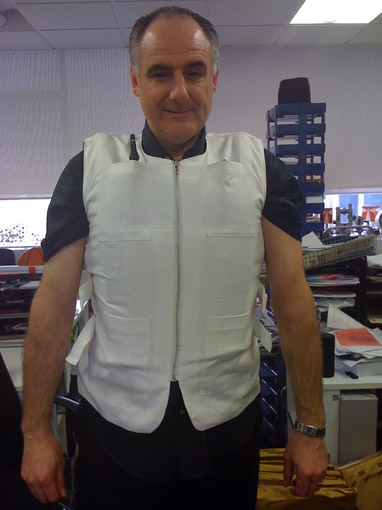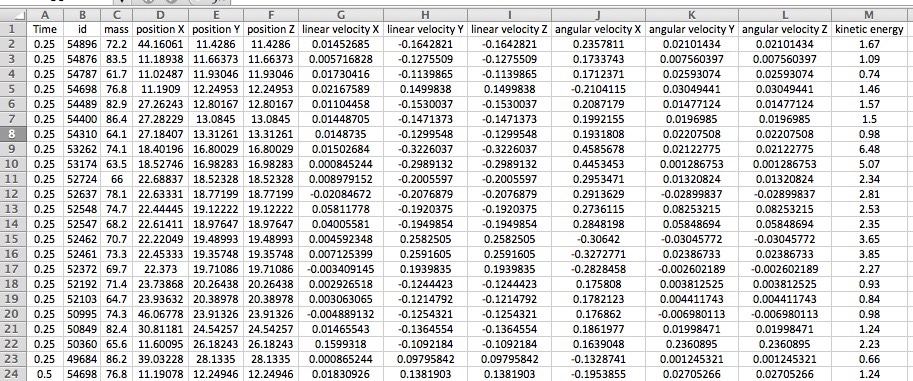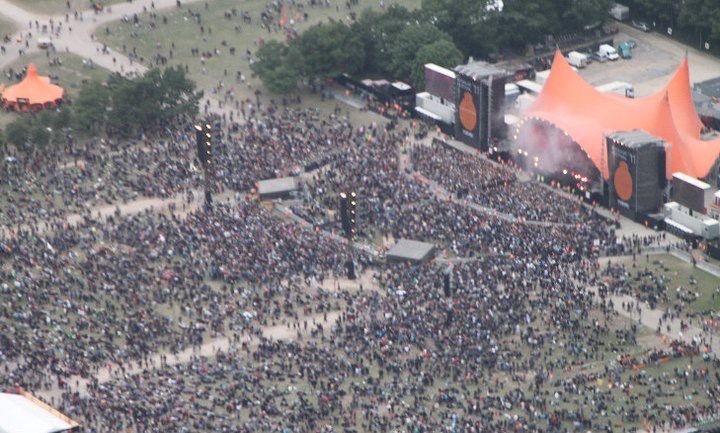From Fruin "Cause and Preventions of Crowd Disasters"
Compressive asphyxia has occurred from people being stacked up vertically, one on top of the other, or horizontal pushing and leaning forces. In the Ibrox Park soccer stadium incident, police reported that the pile of bodies was 3 m (10 feet) high. At this height, people on the bottom would experience chest pressures of 3600-4000 N (800-900 lbs.), assuming half the weight of those above was concentrated in the upper body area.
Horizontal forces sufficient to cause compressive asphyxia would be more dynamic as people push off against each other to obtain breathing space. In the Cincinnati rock concert incident, a line of bodies was found approximately 9 m (30 ft) from a wall near the entrance. This indicates that crowd pressures probably came from both directions as rear ranks pressed forward and front ranks pushed off the wall.
Experiments to determine concentrated forces on guardrails due to leaning and pushing have shown that force of 30% to 75% of participant weight can occur. In a US National Bureau of Standards study of guardrails, three persons exerted a leaning force of 792 N (178 lbs.) and 609 N (137 lbs.) pushing. In a similar Australian Building Technology Centre study, three persons in a combined leaning and pushing posture developed a force of 1370 N (306 lbs.). This study showed that under a simulated "panic", 5 persons were capable of developing a force of 3430 N (766 lbs.).
_________________________________________________
Scientific paper published in "Medicine, Science and the Law” April 2017
Acute forces required for fatal compression asphyxia: A biomechanical model and historical comparisons
Mark W Kroll, G Keith Still, Tom S Neuman, Michael A Graham and Lanny V Griffin
Conclusions
A biomechanical ribcage model predicts that an adult male requires at least 2550 +/- 250 N (260 +/- 26 kg) of static chest mass to cause flail chest. This is consistent with the records of judicial pressing. The model predicts that an adult male requires 4050 +/- 320 N of dynamic force to cause flail chest.
_________________________________________________
Pressure suit research project
 The suit (left) measures the pressure, temperature of the subject. Using telemetry we can monitor the crowd state and pressure on the test subjects and barrier system. Coupling this with video analysis we are calibrating the above progressive crowd collapse and shockwave modelling tool.
The suit (left) measures the pressure, temperature of the subject. Using telemetry we can monitor the crowd state and pressure on the test subjects and barrier system. Coupling this with video analysis we are calibrating the above progressive crowd collapse and shockwave modelling tool.

Above - the output from the modelling tool is checked against the data from the field (barrier pressure monitoring and suit pressure monitoring). We can experiment with excitation and assess risks of surging and pressure/shock waves in the crowd. Mapping excitation from video clips, set and beat analysis and pressure readings from field tests. See below for survey images. This research was sponsored by Mojo and Roskilde.
Some citations on crowd forces
1. Tolerable force against 100m flat bar 623N (Men) up to 800N when they could push back
This is extracted from : "Crowd Pressure Monitoring" by IHG Hopkins, SJ Poutney, P Hayes and MA Sheppard published in "Engineering for Crowd Safety" RA Smith and JF Dickie (Editors) in 1993 by Elsevier.
2. Dangerous Crowd Pressure
“When pushed against a 100mm wide flat bar, the tolerable force was typically 140lbf (623N) for men. When allowed to push back against the bar, to reduce loading on the rib cage, this force increased to typically 180lbf (800N). The tolerable force or women was reported to be significantly less. ....
.... the method was essentially subjective in that it established the discomfort or anxiety threshold of the volunteer.”
3. Crush Asphyxia 6227N for 15 seconds
4. Crush Asphyxia 1112N - if sustained for 4-6 minutes
Also from
"Crowd Pressure Monitoring" by IHG Hopkins, SJ Poutney, P Hayes and MA Sheppard published in "Engineering for Crowd Safety" RA Smith and JF Dickie (Editors) in 1993 by Elsevier.
5. Dangerous Crowd Pressure
“Firstly, death was estimated to have occurred 15 seconds after a load of 1440 lbf (6227N) was applied. In the second case it was estimated that death occurred after 4 - 6 minutes of applying a load of 250lbf (1112N).
6. 3 people pushing can exert a force of 1370N
7. 5 people pushing can exert a 3430N force
are from “The Causes and Prevention of Crowd Disasters” by John J. Fruin, Ph.D., P.E. United States of America. (Originally presented at the First International Conference on Engineering for Crowd Safety, London, England, March 1993. Elsevier Science Publishers B.B. © 1993)
“Force
“Crowd forces can reach levels that almost impossible to resist or control. Virtually all crowd deaths are due to compressive asphyxia and not the "trampling" reported by the news media. Evidence of bent steel railings after several fatal crowd incidents show that forces of more than 4500 N (1,000 lbs.) occurred. Forces are due to pushing, and the domino effect of people leaning against each other.
“Compressive asphyxia has occurred from people being stacked up vertically, one on top of the other, or horizontal pushing and leaning forces. In the Ibrox Park soccer stadium incident, police reported that the pile of bodies was 3 m (10 feet) high. At this height, people on the bottom would experience chest pressures of 3600-4000 N (800-900 lbs.), assuming half the weight of those above was concentrated in the upper body area.
“Horizontal forces sufficient to cause compressive asphyxia would be more dynamic as people push off against each other to obtain breathing space. In the Cincinnati rock concert incident, a line of bodies was found approximately 9 m (30 ft) from a wall near the entrance. This indicates that crowd pressures probably came from both directions as rear ranks pressed forward and front ranks pushed off the wall.
“Experiments to determine concentrated forces on guardrails due to leaning and pushing have shown that force of 30% to 75% of participant weight can occur. In a US National Bureau of Standards study of guardrails, three persons exerted a leaning force of 792 N (178 lbs.) and 609 N (137 lbs.) pushing. [9] In a similar Australian Building Technology Centre study, three persons in a combined leaning an pushing posture developed a force of 1370 N (306 lbs.). [10] This study showed that under a simulated "panic", 5 persons were capable of developing a force of 3430 N (766 lbs.).
[9] Fattal, S.G., Cattaneo, L.E. Investigation of Guardrails for the Protection of Employees From Occupational Hazards. Nat. Bur. Stds. NBSIR 76-1139, July 1976, 114 pp.
[10] Horizontal Loading on Handrails. NBTC Tech. Rec 514, Nat.Tech. Centre, New South Wales.
8. 20% compression of the chest cavity can break ribs - this is around 3000N (from medical bone fracture analysis) so we can see that there is a potential for a 5 person deep push to break ribs.
is from “Biomechanics of Chest and Abdomen Impact” (David C. Viano, Albert I King) 2000 CRC Press LLC (which I’ve attached)
9. Gross Bone Fractures (Pathological and physical parameters) are around 6920N - which is above the concert and football barrier tolerances (5400N)
is from
Patellofemoral Joint Fracture Load Prediction using Physical and Pathalogical Parametres” Proceedings of the 1998 SAE International Congress and Exposition. SAE 980358 by PJ Atkinson, CM Mackenzie and RC Haunt.
_____________________________________________
Prediction of Human Crowd Pressures (Ris S.C. Lee, Roger Hughes) Accident Analysis and Prevention 2006 Elsevier. Is a collection of the above on one paper.
_____________________________________________

Above - Roskilde 2011 - Orange Stage.
Below - 4 of the 6 pressure suits used in the survey/analysis.
Below - using the calibration grids to assess the pressure differential through the crowd.
Below - fluorescent hats identifying the students
Below - telemetry system monitoring the pressure and temperature of the suits